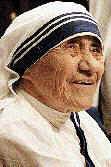Mother Teresa
Healer of the Sick, Friend of the Poor
d. 5 September 1997
 Mother Teresa was born in
1910 of Albanian parents in Skopje, christened Agnes Gouxha Bojaxhiu, and educated at the
local government school. She was first inspired by the writings of Pope Pius XI and also
by the letters written to the school by Jesuit missionaries who were working among the
poor in India, in the archdiocese of Calcutta.
Mother Teresa was born in
1910 of Albanian parents in Skopje, christened Agnes Gouxha Bojaxhiu, and educated at the
local government school. She was first inspired by the writings of Pope Pius XI and also
by the letters written to the school by Jesuit missionaries who were working among the
poor in India, in the archdiocese of Calcutta.
She felt called to join a religious order, and entered the congregation of Loreto nuns who worked in Bengal. Before going to India she was sent to learn the English language in Dublin. From Ireland, she went to Darjeeling, and found herself completing her novitiate in the famous Loreto School, where the daughters of the rich Indians and colonials obtained the best public school education for their children. On March 24, 1931, Agnes Bojaxhiu made her first vows and took the name of Teresa.
The young Sister Teresa was transferred to St Mary's School, Entally, where she taught geography and history for 17 years. It was here that she took her final vows on May 24, 1937, and eventually became the principal of the school.
In December 1948, after her medical training in Patna, Sister Teresa returned to Calcutta and initially stayed with the Little Sisters of the Poor. Bengal had been torn by riots resulting from the religious conflicts between Hindu and Muslim. In the city there were tens of thousands dying of starvation, tuberculosis, leprosy and other diseases resulting from malnutrition. Teresa was not afraid, although she knew the immensity of her task, and she began work by starting a pavement school for the slum children, teaching them to write using the mud and dust as a blackboard.
On March 19, 1949, a small, shy former Bengali pupil, Subhasini Das, became Mother Teresa's first postulant, and took her old name of Agnes. She was followed by nine other former students who formed the nucleus of her community, the Missionaries of Charity.
In 1952, through the Missionaries of Charity, Mother Theresa opened Nirmal Hriday (Pure Heart) Home for Dying Destitutes. In 1965, the order was recognised as a papal congregation under the protection of the Vatican and in 1967 a Congregation of Brothers was formed. Mother Teresa was well aware that although her community was increasing at an alarming rate, it was still important that lay people should be involved with the work amongst the destitute and in 1969 a constitution was drawn up in Rome to unite these co-workers into one association. There were eventually tens of thousands of lay people including a special group called the sick and suffering co-workers from more than 40 countries.
She always maintained that those in her community were really contemplatives rather than social workers, hence although they cared for the dying, handicapped and even minute premature aborted babies, the nuns were never to be considered a nursing order. Because she saw Christ in all people, then their work was contemplation. When she first heard that she was to receive the Nobel award she said: "I accept the prize in the name of the poor. The prize is the recognition of the poor world. Jesus said: 'I am hungry, I am naked, I am homeless.' By serving the poor, I am serving him."
She made use of the opportunity to expound her total opposition to abortion. "The world has given me the Nobel Prize," she said as she was about to leave for Oslo in December, 1979, "but I ask the world for a gift I want the abortion laws abolished. This would be a real gift." At her request, the traditional dinner at the prize awarding ceremony was cancelled and the money it would have cost was added to her prize money.
In 1980 Prince Charles was one of the VIP visitors to her children's orphanage in Calcutta, and in 1983 the Queen also came to make Mother Teresa an honorary member of the Order of Merit, the only non-British subject to be so recognised.
More than anyone else of her time, Mother Teresa came to be regarded by millions as the embodiment of human goodness. By her compassion, humility and, it also has to be said, shrewd eye for publicity, she raised public concern for the destitute; by devoting herself with single-minded vigour to the relief of human suffering, she galvanised individuals, both believers and non-believers, and even governments into action. Not since Albert Schweitzer has any one person had such an inspirational effect. She died at the age of 87 on 5 September, 1997.
Acknowledgements:
Text adapted from the
Sunday Times
Image from the
Sunday Times